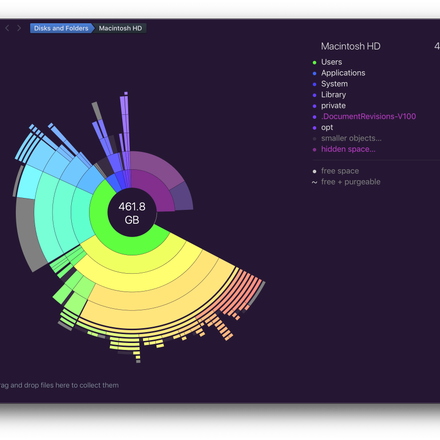Hidden space What is hidden space. Sometimes the total size of all scanned files and folders on a disk still don’t make for the entire used space on that disk. This happens because there may be some restricted folders, which DaisyDisk couldn’t scan with default permissions, or which are even entirely unreachable. Nov 06, 2018 DaisyDisk found that I've got 135gb of 'Hidden Space', 127gb of which is 'Still Hidden' and DaisyDisk is 'Unable to locate' I've tried all of the listed items on their support page for this and none of them have solved my problem. I've also contacted their support team but have yet to hear back. Apr 16, 2018 During this time, you may see 'still hidden' in DaisyDisk appearing unusually large. Later on, 'still hidden' will be converted into 'purgeable space', which you can either forcedly delete (in DaisyDisk) or let macOS delete it later upon need. Jul 21, 2018 DaisyDisk shows them as 'purgeable space' (inside the 'hidden space'). Even after 'purging' the purgeable space it in DaisyDisk, it may require some time for macOS to complete its background snapshot tasks and release the disk space. In the meantime you may see the 'still hidden' space grow temporarily. Alternatives to DaisyDisk for Windows, Mac, Linux, BSD, Android and more. Filter by license to discover only free or Open Source alternatives. This list contains a total of 25+ apps similar to DaisyDisk. Disk space analyzer. If you're looking for more info about DaisyDisk like screenshots, reviews and comments you should visit our info page.

| Developer(s) | Software Ambience |
|---|---|
| Initial release | 2008 |
| Stable release | 4.10 (March 8, 2020; 41 days ago[1]) [±] |
| Operating system | macOS |
| Available in | English, German, French, Italian, Russian, Simplified Chinese, Traditional Chinese, Japanese, Swedish, Spanish, Polish[2] |
| Type | Disk space analyzer |
| Website | daisydiskapp.com |
| Usage | |
DaisyDisk is a paid disk space analyzer for macOS.[3] It displays a sunburst diagram of files on a hard drive to help with the location or deletion of large files.[4] It can display previews of files using Quick Look.[5][6][7] It also allows the user to look at the file directly in Finder, in order to delete it or move it elsewhere.[8]
OS X下的hidden space越来越大,也找不到删除的办法。. DaisyDisk is a paid disk space analyzer for macOS. It displays a sunburst diagram of files on a hard drive to help with the location or deletion of large files. It can display previews of files using Quick Look. It also allows the user to look at the file directly in Finder, in.
History[edit]
DaisyDisk was started in late 2008 by interaction designer Taras Brizitsky and programmer Oleg Krupnov. They built the codebase from scratch to try to achieve higher speeds than similar programs. They decided to use a sunburst diagram as it is perceived better than other ways of visualizing data (such as treemaps).[9]

Features[edit]
DaisyDisk needs to scan the disk to create a map of its files and folders. Once the initial scan is completed, DaisyDisk keeps all displayed information up to date and reflects all changes to disk in real-time. DaisyDisk can scan multiple disks in parallel.
With v4.5[10] of DaisyDisk, support for APFS was added.[11]
Interface[edit]
DaisyDisk displays the contents as a color-coded sunburst diagram, resembling the petals of a daisy.[12] The interface places the root of the hard drive at the center of this daisy, and displays a hierarchical structure of that hard drive's file system that radiates from that center. This daisy is color-coded to differentiate between folders, while files themselves are always displayed as gray. In the right sidebar of the interface, DaisyDisk also provides a legend for these color codes. When hovering over a file or folder, the right sidebar of the interface updates with contextual information such as the file or folder name and their absolute path.[13] When clicking on a folder on the daisy, a new daisy is displayed with the chosen folder as its root. The interface shows a 'breadcrumb trail' of the current folder right above the sunburst diagram.[6]
DaisyDisk provides a Trash-like collector icon in the lower left of its interface where files and folders can dragged and dropped for deletion.[13]
As of DaisyDisk v3, a specialized version of the app exists for Mac users with Retina Displays.[14]
Integration[edit]
One of the ways DaisyDisk integrates with the Mac features is through its support of the Quick Look function, which is included in Mac OS X v10.5 'Leopard' and later. Hovering over any file or folder in DaisyDisk's interface and pressing space bar utilizes Quick Look and displays additional information about that file or folder in regards to its location and contents.[12]
References[edit]
- ^'DaisyDisk Release Notes'. Retrieved 9 March 2020.
- ^'DaisyDisk Blog'. Software Ambience.
- ^'DaisyDisk 4.6.2 free download for Mac'. MacUpdate. Retrieved 19 June 2018.
- ^'DaisyDisk 4 Review'. Macworld. Retrieved 19 June 2018.
- ^'DaisyDisk: Tom's Mac Software Pick'. Lifewire. Retrieved 11 March 2019.
- ^ ab'DaisyDisk: Futuristic Data Visualization'. Mac.AppStorm. Retrieved 20 June 2018.
- ^'How to identify the biggest space wasters on your Mac with DaisyDisk'. iDownloadBlog. Retrieved 19 June 2018.
- ^'Make Your HD Bigger with DaisyDisk for Mac [Review]'. Cult of Mac. Retrieved 11 March 2019.
- ^'An Evaluation of Space-Filling Information Visualizations for Depicting Hierarchical Structures'(PDF). Georgia Institute of Technology. Retrieved 2 June 2010.
- ^'Top 5 questions about APFS and macOS High Sierra asked by Mac users'. DaisyDisk Blog. Retrieved 20 June 2018.
- ^'How to free up disk space in macOS High Sierra'. Cult of Mac. Retrieved 20 June 2018.
- ^ ab'Review: DaisyDisk: Disk Visualization and Analyzer Tool for the Mac'. aboutTechnology. Retrieved 13 November 2014.
- ^ ab'Make Your HD Bigger with DaisyDisk for Mac [Review]'. Cult of Mac. Retrieved 13 November 2014.
- ^'DaisyDisk Blog'. Software Ambience. 7 September 2013. Retrieved 5 January 2019.
Daisydisk Still Hidden Space Program
Large amounts of hidden disk space may also indicate errors in the file system. You can use the Disk Utility to verify and repair your disk’s integrity. In some cases, you may need to boot your Mac in Recovery mode and run the Disk Utility from there.In the most obstinate cases with APFS disks, you may need to use the lower-level fsck_apfs command-line utility to verify and repair the APFS volume from the Recovery mode.
Daisydisk Still Hidden Space Designs
Similarly, for HFS+ disks, you may need to use fsck_hfs. Beside verifying, you can use it to repair the HFS+ catalog file. WARNING: this operation may not be safe for your data! You should make a full backup of your disk before trying. Please seek professional help on the matter.